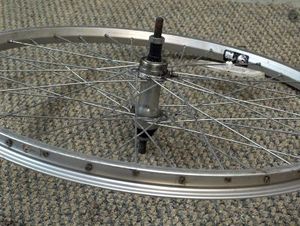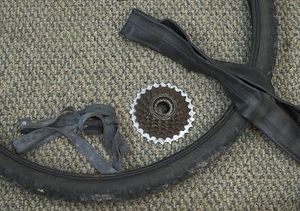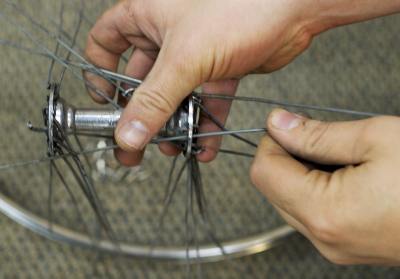Despoking Wheels
Despoking wheels is a good task for a new volunteer. It also benefits the organization by getting unserviceable wheels converted into several useable parts, and the volunteer benefits by doing a relatively easy and interesting task, getting experience using spoke wrenches and a feel for spoke tension, and learning about the parts of a wheel and about how wheels are constructed.
Before you start despoking a wheel, it should have all parts which are not built into it removed. This of course includes its tire and tube, but also the rim strip, which runs along the outside of the rim to protect the tube from the spoke ends and niplpes. There is a box for rubber rim strips in the area near the spoke motel. Cloth rim strips are not re-useable. If the wheel has a quick release hub, you should remove the skewer. Skewers (with their springs!) are kept in a box in the cabinet in the shop that is covered in stickers. For rear wheels, GEARS MUST BE REMOVED!
Some people find it easier to start the despoking process with the wheel in the truing stand. If the stand is available, you might try it this way. Whether you choose to work in the stand or just sitting in a chair, the primary task of despoking is loosening the spokes so that you can separate the parts of the wheel. It is a good idea to start with the appropriate spoke wrench. It's easiest to first loosen all the spokes with the wrench, and then you can turn the nipples with your fingers, or from the outside of the rim with a screwdriver.
If you are using the truing stand, as the spokes get very loose the wheel will become hard to handle and it will be easier at some point to remove the wheel from the stand and continue sitting down. Once you start loosening nipples far enough that they come off of the spokes, put the nipples in a cup and you can work each spoke between the other spokes to pull it through its hole in the hub.
Continue this until you are left with a pile of spokes, a cup of nipples, a hub, and a rim. If you have to bend a spoke a bit to get it out, that is fine.
One problem that you might have despoking a wheel is frozen spokes or rounded nipples. If you are turning a nipple and the spoke is turning with it, or if the nipple is frozen to the rim and you are unable to turn it at all, you will not be able to remove that spoke normally. If a nipple is rounded, you can try to remove it using a screwdriver from the back, but sometimes the nipple is rounded because it was frozen. In the event that you cannot loosen a nipple, you will have to cut the spoke using wire cutters, and both the spoke and nipple will be scrap. If you have a rounded nipple that you manage to get loose, keep the spoke and scrap the nipple.
There are two possible futures for the spokes. If the spokes are in better shape than other spokes of the same length in the spoke motel, they will go there. Otherwise, they will go into the steel scrap bin (the large wire bin under the kitchen table). It is a good idea to measure a spoke's length early in the process and check the drawer for that length. If you know that you will be scrapping the spokes, you can leave the nipples off and collect them in a pile (you will still save the nipples).
The hub and rim will go into the appropriate piles to be sorted. If the rim is steel, the appropriate pile is the art parts bin, where the spokes can be used for creative projects.



